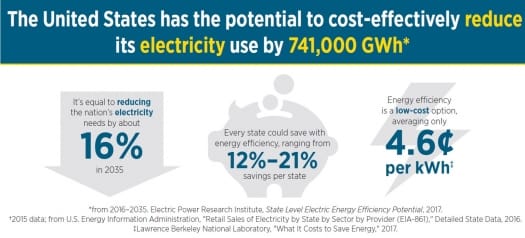No time to retreat on energy efficiency: Part 2
Last week, part 1 of this post focused on the Northwest’s impending shortfall in meeting 7th Power Plan goals for energy efficiency as well as plans by Bonneville Power Administration (BPA) to cut funding for energy efficiency efforts by 10% in 2020 and 2021.
That news comes against the backdrop of efforts by the Trump administration and federal agencies to undermine an entire menu of national energy efficiency standards.
Automotive Fuel Efficiency: The administration’s August 2018 proposed ruling would roll back or freeze fuel economy goals, end requirements for the production of hybrid and electric vehicles, and eliminate provisions that enable states to set more aggressive requirements.
- Electric Appliance Efficiency: In its most recent budget proposal, the administration recommended making the Environmental Protection Agency’s highly successful Energy Star program, which enables purchasers to readily identify fuel- efficient appliances, a voluntary, industry-funded program. Meanwhile, administration efforts to stop enforcement and undo new regulations on portable air conditioners, walk-in coolers and freezers, commercial boilers, and uninterruptible power supplies are tied up in court.
- Lighting Efficiency: Last week it was reported that a new proposal undergoing White House review would stop the expansion of energy-use requirements for bulbs used in track and recessed lighting, bathroom vanities, and decorative fixtures.

In 2017, a Carbon Brief analysis determined that annual carbon dioxide emissions in the United States declined by 14% between 2005 and 2016. Forty-five percent of the reduction is attributable to improvements in automotive,
appliance, and lighting efficiency. Coal-to-gas power plant conversions accounted for another 33%. And 20% came from the development of wind and solar energy.
In short, although improvements in energy efficiency don’t receive as much attention as the ongoing decline in coal-fired power generation and aren’t as visible as wind turbines and solar panels popping up across the landscape, they are the most effective tool we have to reduce consumption, save money, and slash greenhouse gases.
Andrew deLaski of the Appliance Standards Awareness Project recently observed that light bulb efficiency standards alone will save consumers more than $5 billion on electricity bills this year and, by 2025, the number will reach $22 billion. That’s about $180 in savings for the average household, money that will ripple through the economy to create an additional 115,000 jobs by 2025. The rollback on lighting standards proposed by the Trump administration would cut the savings and the job growth by more than half.
In the May, 2018 issue of The Electricity Journal, David B. Goldstein of the Natural Resources Defense Council argues that energy efficiency isn’t only the least expensive energy resource, it’s net cost is close to zero once non-energy benefits are accounted for. Non-energy benefits can include improvements in health, safety, and comfort as a result of repairs and energy efficiency upgrades to homes and increased worker productivity as a result of improved workplace conditions.
Another often-ignored benefit of energy efficiency is that many measures can be implemented quickly, which means the benefits start accumulating almost immediately. Upgrades to existing structures and the replacement of outmoded equipment and appliances can start the day policies are adopted creating benefits that grow over time. That’s important when we’re racing against clock to prevent the worst consequences of climate change.
Finally, combined with demand-side management practices, energy efficiency reduces both overall and peak demand for electricity, which makes it easier for energy systems to integrate new renewable resources such as wind and solar.
Rather than retreating on energy efficiency, we should increase investments. At the same time, we must design better business models and develop public policies to provide stakeholders — utilities, homeowners, building owners, businesses, and others — with the incentives they need to wholly embrace energy efficiency.


 Automotive Fuel Efficiency: The administration’s August 2018 proposed ruling would roll back or freeze fuel economy goals, end requirements for the production of hybrid and electric vehicles, and eliminate provisions that enable states to set more aggressive requirements.
Automotive Fuel Efficiency: The administration’s August 2018 proposed ruling would roll back or freeze fuel economy goals, end requirements for the production of hybrid and electric vehicles, and eliminate provisions that enable states to set more aggressive requirements.